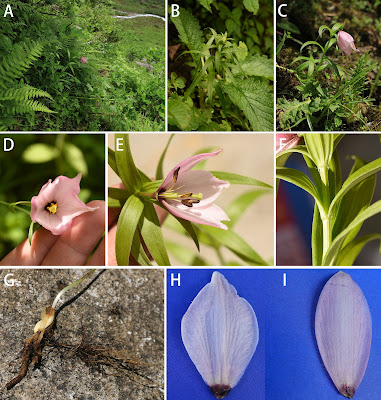 |
| Lilium liangiae Y. M. Yuan & Y. D. Gao, in Yuan et Gao, 2024. |
The former genus Nomocharis, which has been merged as a clade within the genus Lilium (Liliaceae), represents one of the most complicated and unclear groups included in the latter. Research on members of the Nomocharis clade has been quite limited due to the sampling difficulties caused by its selective environmental preferences. In this study, we propose a new species within this clade, Lilium liangiae, as a further bridge connecting the former genus Nomocharis with other members of the genus Lilium. We conducted morphological clustering, phylogenetic, and comparative genomics analyses of nuclear internal spacers and the newly generated complete chloroplast genome, in conjunction with previously published sequences, and performed ancestral state reconstruction to clarify the evolutionary pattern of important traits in Lilium. The clustering results of 38 morphological traits indicated that the new species is allied to Nomocharis, further increasing the morphological polymorphism in the latter. The phylogenetic results and morphological clustering both supported L. liangiae belonging to the subclade Ecristata in Nomocharis, its closest affinity being Lilium gongshanense. Inconsistencies in phylogenetic relationships were detected between nuclear and plastid datasets, possibly due to ancient hybridization and ongoing introgression. Comparative genomics revealed the conservation and similarity of their chloroplast genomes, with variations observed in the expansion and contraction of the IR regions. A/T and palindromic repeat sequences were the most abundant. Seven highly variable regions (Pi≥0.015) were identified as potential molecular markers based on the chloroplast genomes of 47 species within Lilium. Both nuclear and plastid genes exhibited very low variability within the Nomocharis clade, contrasting with their highly variable morphological appearance. The ancestral state reconstruction analysis suggests that the campanulate flower form, as in L. liangiae, arose at least three times within the genus Lilium, revealing parallel evolution in the latter. Overall, this study adds important genetic and morphological evidence for understanding the phylogenetic relationships and parallel evolution patterns of species within the genus Lilium.
 |
| Morphological characteristics of Lilium liangiae. (A) Habitat. (B, C) Plant. (D) Flower. (E) Anatomical view. (F) Tufted hairs. (G) Bulb. (H) Inner tepal. (I) Outer tepal. |
Lilium liangiae Y. M. Yuan et Y. D. Gao sp. nov.
At first glance, the new species bears a slight resemblance to Lilium mackliniae in terms of perianth morphology. Both have bell-shaped nodding flowers with petals curving upward at the end, and the petal edges transition from white to a deeper pink toward the center. Nonetheless, they significantly differ in overall plant morphology and leaf shape, with L. liangiae being shorter and smaller, typically bearing only one flower.
Yumei Yuan and Yundong Gao. 2024. Lilium liangiae, A New Species in the Genus Lilium (Liliaceae) that reveals parallel evolution within morphology. Front. Plant Sci. 15. DOI: 10.3389/fpls.2024.1371237
